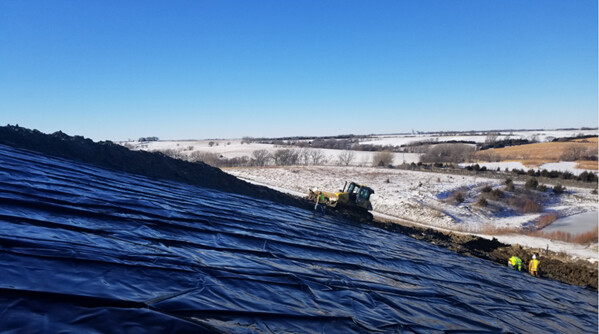
Area landfills conjure up so many negative feelings for a lot of people — the odor, the litter — it’s no wonder so many communities are struggling to find new locations for them. Working to create a better environment and improve community perceptions, University of Nebraska–Lincoln researchers are investigating ways to remediate gas emission pollution from landfills by using an innovative ground covering system and analyzing its community impact.
A university collaboration led by Jongwan Eun, assistant professor of civil and environmental engineering, and Yunwoo Nam, associate professor of community and regional planning, started three years ago with a grant from the Nebraska Environmental Trust. The team’s goal was to test a new landfill ground covering system made from a co-extruded geomembrane with an ethylene vinyl-alcohol layer sandwiched between two inner, low-density polyethylene layers. This new system has been tested against traditional covering systems consisting of low-density polyethylene and no covering at all in recent field tests.
Reducing gas emissions is particularly important for the environment because landfill gases are not only the third largest source of greenhouse gases in the United States, but they include hazardous, noxious gases that often upset landfill neighbors, resulting in strained relationships with the community, regulatory actions and, in some cases, costly litigation for communities. Poor community perceptions of landfills also negatively impact the selection of future waste management sites as residents embrace NIMBY (Not In My Backyard). This research is of particular interest not only to environmentalists, but planners, legislators and community administrators as they manage current and future sites.
Mitigating gas emissions was a major component of the research project, in addition to gathering, analyzing and evaluating data regarding the new system’s potential impact to any given community using gas dispersion modeling. Using geographic information system and engineering data, the team identified and evaluated the boundaries of simulation results to ascertain how far the gases would have an impact in any given community. Knowing how far the gas travels with this new covering system is important data to consider for any city administrator or stakeholder interested in implementing the new technology.
Although the testing for the new cover is ongoing, preliminary results are promising. The new system has proven to reduce gas emissions by 20 times the normal amount and increase gas collection by three times in laboratory and field tests in Butler, Nebraska.
As part of the field test, the team assessed the new landfill cover’s impact on the Butler community. Using GIS and data collected through the state of Nebraska’s Enterprise Content Management system, the team was able to measure the area impacted by gas emissions by analyzing the addresses of resident complaints. GIS mapping of complaints verified the accuracy of the gas dispersion modeling.
Cost effectiveness of the new technology was also analyzed by the team.
“Although initially more expensive to install than the traditional approach, based on our simulation for the sixth and seventh year, there is a turning point where you will see a return on investment,” Nam said.
In addition to faculty, Master of Community and Regional Planning student Sunah Moon and civil engineering doctoral student Yuan Feng have assisted with research and data collection.
“As a Ph.D. student, I loved working on this project and plan to continue my research work in the future,” Feng said. “This project, as the world’s first, on-site application of EVOH geomembrane, has built a strong foundation for my career. I hope to continue to engage in research that focuses on reducing landfill gas emissions after graduation and contribute my efforts to the protection of the environment.”
Based on the team’s research, this new approach to landfill coverings has promising results. With less gas emissions, higher gas collection and greater return on investment, the method may soon gain traction in communities looking to upgrade their systems.
“For my perspective, my long-term goal for this research project, I wanted to provide information that others can use for a good alternative to control and manage the greenhouse gases from landfills, which will be a huge benefit for the environment,” Eun said.
For Nam and his many research interests in the planning sector, one of the main goals is creating healthier communities. This is certain to be an increasing struggle for community planners and city administrators as the Nebraska population grows, because increased population means increased waste.
“If you change the perception of waste facilities, then residents will not be so opposed to having them built in their neighborhoods,” Nam said. “This is a great example of NIMBY and how it negatively impacts planning and a community’s overall health. But hopefully, the work we do here today will make a positive difference.”







